Pressure-treated wood is a practical and dependable choice for a home’s outdoor space. Even though it needs much less upkeep than raw wood, you should always stain it.
We know the advantages of staining wooden structures. Still, the procedure can occasionally be challenging, particularly if you need to familiarize yourself.
What occurs if you stain treated wood too early is a frequent concern shared by most homeowners.
Pressure-treated wood won’t receive a complete penetration from stain if applied too soon. As a result, you won’t gain from the stain’s defensive properties. Therefore, waiting for the treated wood to dry completely before staining it is preferable.
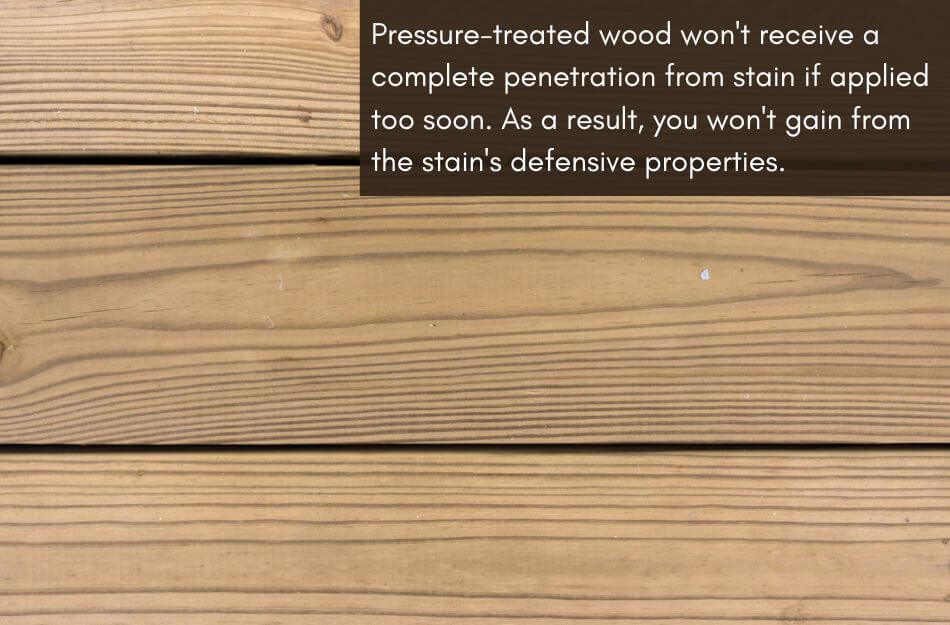
Staining a deck made of treated wood can further protect it from harm. Additionally, it enhances the exterior structure; however, seeing these effects depends on timeliness.
We are here to help you with any questions about staining treated wood.
Table of Contents
- 1 Consequences of Staining Treated Wood Too Soon
- 2 How Much Time Does Pressure Treated Wood Need to Dry Out?
- 3 The Right Time to Stain Treated Wood
- 4 How to Determine If The Treated Wood Is Ready for Staining
- 5 What Should You Do If You Stained Too Early?
- 6 How To Prepare Treated Wood For Staining
- 7 Can The Staining Process Be Postponed for a Long Time?
- 8 What Stain Should You Use On Treated wood?
- 9 Conclusion
Consequences of Staining Treated Wood Too Soon
Pressure-treated wood is one of the best materials for building outdoor areas. Treated wood has a life expectancy of over forty years, much longer than natural wood.
Even though the chemical process shields the wood from rot, decay, and breakage, staining is still occasionally necessary.
Especially in humid circumstances, this protective coating keeps your outdoor area maintained. However, the wood treatment chemicals need to dry before beginning the staining procedure.
The treated wood might only produce the desired outcome if you stain it slowly. What occurs when pressure-treated wood is stained earlier is as follows:
The Stain Won’t Penetrate The Wood
If you try to apply stain to treated wood that is still damp and hasn’t completely dried out, the stain won’t be incorporated by the wood.
Your efforts will be in vain because you’ll have to repeat the entire procedure. As you are all aware, stains must permeate the wood to produce effective results; for this reason, the wood surface must be dry.
Also Read: Best Temperature Ranges For Staining Deck
The Chemical Could Get Through The Wood
The chemicals that were used to treat the wood may attempt to escape the wood and leave blisters, which presents another possible issue when staining newly treated wood.
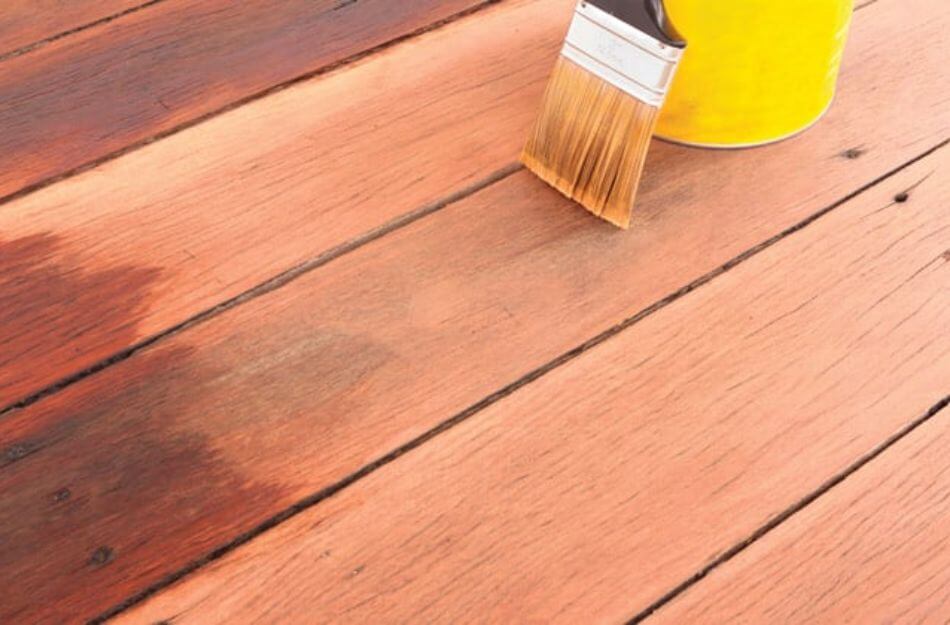
It implies that your sealer will be less effective, and your efforts will be for naught.
Costs of Maintenance Will Rise
Installing an outdoor area, particularly one made of wood, improves the aesthetic worth of your house, but they are expensive. Similar to the previous aspect, maintaining wood can be expensive.
Although occasional staining is the only aftercare required for treated wood, remember that stains are also an investment; high-quality stains are pricey, and you can save them quickly.
Therefore, giving the treated wood time to dry fully before staining it would be beneficial.
How Much Time Does Pressure Treated Wood Need to Dry Out?
Depending on the humidity of the surroundings, pressure-treated wood will typically take two to three weeks to dry out. However, this time may need to be extended.
You can ensure you have all the necessary tools for the remaining steps during this period.
The fantastic thing about pressure-treated wood is its ability to withstand the elements. When you want to stain it, that good becomes negative. It may need time to dry completely.
Picking out paint rollers or brushes, getting your cleaning supplies ready, and deciding on the stain color are all excellent ways to prepare for the next stage.
The Right Time to Stain Treated Wood
It is more than a general recommendation to wait until the pressure-treated substance has dried. If you don’t follow the advised drying time, the exposed wood pores will refuse the stain application.
Due to incomplete chemical processing, it frequently occurs. Consider the weather, ebbs, and flows of the seasons when staining treated wood. It works best to let it air dry for at least a month.
How to Determine If The Treated Wood Is Ready for Staining
Determining the time for treated wood to get ready for staining is crucial otherwise it will harm your deck and surrounding area.
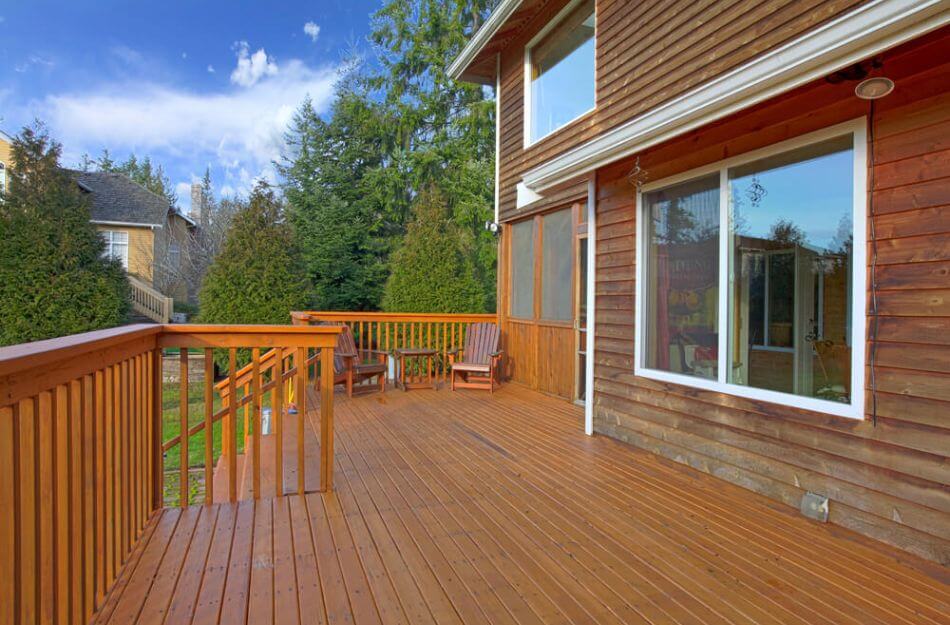
Due to these issues you can be in trouble in terms of the expense because all these procedures need proper time and money. Following are the ways to determine the wood:
Sense Test
Press a towel over the surface to check for moisture before adding a specific stain to the material. Ensure the wood is prepared for staining because no wetness is felt during this initial sense test.
You can skip the next stage if the pressure-treated surface fails this test. Instead, we advise keeping up the drying process until the substance shows no signs of moisture.
Water Test
Once the substance has passed the sense tests, run a cup of water over its surface. Pressure-treated wood can eventually be stained or painted if it absorbs the liquid.
If the water beads don’t disappear, you’ll need to give the cloth more time to dry.
Don’t Miss: When To Stain A New Deck: Ultimate Deck Staining Guide
Electronic Moisture Tests
The moisture content of the substance should then be determined using a digital moisture meter. The easiest way to determine the wood’s average moisture content is to move the tool over various areas.
What Should You Do If You Stained Too Early?
There are still methods to save your pressure-treated wood if you unintentionally stained it earlier than you meant and the stain didn’t adhere properly.
If you use a lighter stain, you must wait until the wood is completely dry before applying another layer of stain.
The expert advises beginning with light stains because the preceding layer was lighter, and it is nearly difficult to see any flaws.
Now, if you choose a darker stain or the application didn’t go as intended, your only option is to remove the top stain coating. Sandpaper or chemical stain removers can be used to get rid of it.
Alternatively, refinish the treated wood for a brand-new, clear start.
How To Prepare Treated Wood For Staining
Before staining the treated wood it is recommended to prepare it in order to remove any dust and debris from it. The methods for correctly applying stain are as follows:
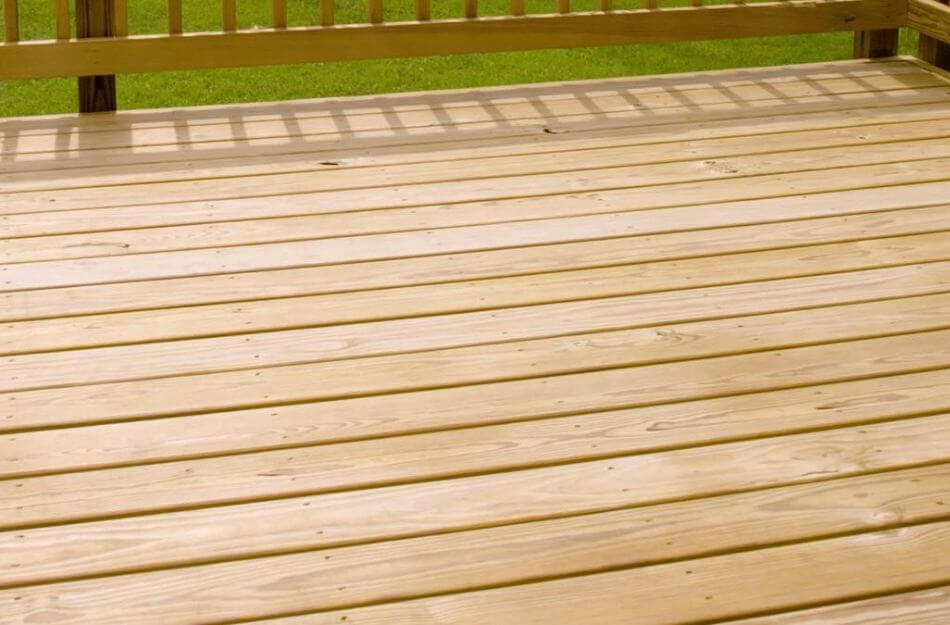
Check the Weather
Although pressure-treated wood has generally improved, it is still susceptible to factors like humidity and the heat of direct sunlight.
As a rule, wait two to three days for dry conditions before staining your pressure-treated wood deck. The stain you apply will dry more quickly in humid conditions.
Thus, we advise starting the cleaning and staining procedure on the third day of warm weather. Additionally, avoid staining treated wood outside in the sunlight. The stain will rapidly evaporate due to the heat before the wood can absorb it.
Verify That The Wood is Dry
It’s crucial to ensure your pressure-treated wood is dry before applying the stain. After purchasing it from the shop, the wood will dry for two to three weeks. It is advised that you occasionally check the moisture content of the wood during this time.
It is essential because the wood can be overdried. The stain loses its inherent ability to adhere to the wood if it dries out too much. The powder test can be used to determine whether it is sufficiently dry.
First, spritz the wood with a little water. The wood is still moist if water beads form on the damp area.
On the other hand, if the water is absorbed, the surface is dry and suitable for staining. A different option is to hammer a nail into the wood. You must wait longer if water leaks while squeezing the nail, though.
However, you can purchase a moisture meter if you need more clarification. Less than 19 percent moisture content is considered optimal. Nineteen is crucial because experts think mold and rot begin to develop at this point.
The pressure-treated wood should be stacked in a crisscross pattern to enable air to dry it. Two to three days are required for the wood to dry. It is ideal to do this when the weather is warm and dry.
Pick the Appropriate Stain
Oil-based and latex stains are the two kinds of stains readily available on the market. Given that each mark has benefits and drawbacks, none is better. Therefore, the best stain depends on the job.
It is preferable to use oil-based stains when building a new deck because the wood fully absorbs them, protecting it from moisture.
Additionally, this extra layer shields against ultraviolet radiation because the stain will soak into the wood.
Pressure-treated wood looks more natural when stained with oil-based products. This kind is available in various wood tones, such as cedar, oak, and redwood. Alternatively, you could choose a translucent or semi-transparent stain.
Your deck will eventually gain more character due to the old, exposed wood and the transparent or semi-transparent stain, allowing the wood’s inherent beauty to shine.
An oil-based exterior stain’s short shelf life is a drawback. Stains will be applied annually. Additionally, algae, fungi, and mildew eat the oil.
On the other hand, latex or water-based stains dry rapidly. This stain clings to the wood and absorbs it even when damp.
In addition, cleaning this is simpler since grime can be removed with just soap and water.
The drawback is that a water-based stain gives the wood a paint-like finish, obliterating the patterns in the wood’s natural grain and removing the wood’s natural appearance.
Scrub the Wood
Use a stiff brush, water, and mild detergent to remove the dirt and residue. Using soapy water instead of a power washer is preferable. Your treated wood’s chemical preservatives can be removed with a pressure washer.
Let the Wood Dry Out
Remain patient until the wood is sufficiently dry. Unfortunately, it might take a few weeks. It is required so that the stain’s chemicals can adhere to the wood and correctly absorb it.
It is best to carry out the above-water test to ensure the wood is completely dry.
Once more, pay attention to whether or not crystals appear on the wood’s surface, which indicates whether the wood is sufficiently dry.
An alternative is to use a moisture level meter to determine the amount of moisture. You can now start staining the pressure-treated wood for your endeavor.
You May Also Find Helpful: Vapor Barrier Under Deck: The Best Moisture Barrier Options
Can The Staining Process Be Postponed for a Long Time?
Yes, it is possible to postpone the staining process a little, but remember that the longer you wait, the more likely your treated wood will sustain harm, decay, or insect infestations.
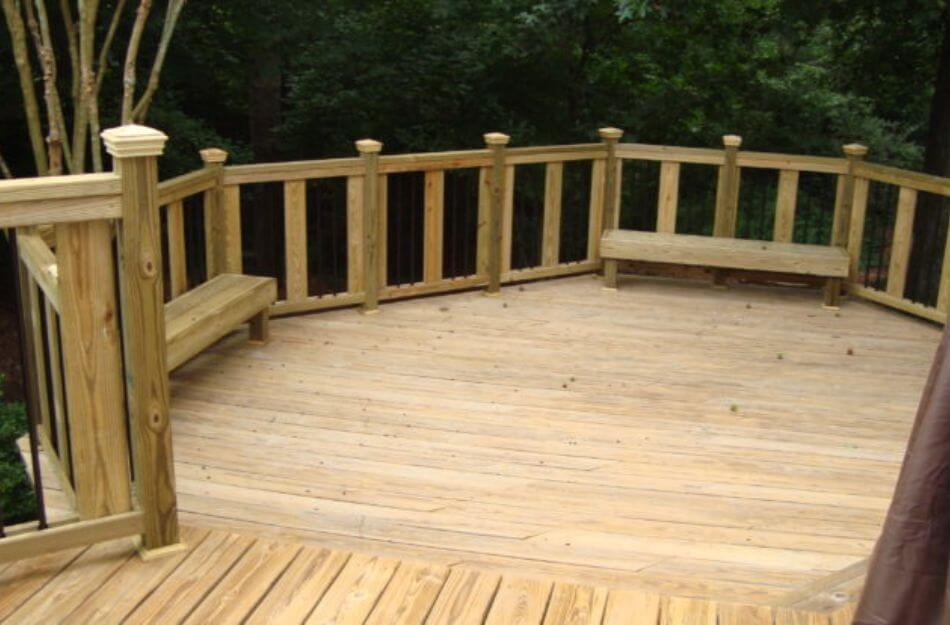
Determining whether the wood is sufficiently dry before applying a protective stain layer as soon as feasible is advised.
Furthermore, just as too much moisture can make stains difficult to remove, too little moisture can also make stains difficult to adhere to surfaces.
Before staining, the optimal moisture content for wood is around 15%. If not, you might need to purchase extra items for improved stain application.
What Stain Should You Use On Treated wood?
Choosing a stain for your treated wood can be difficult with so many choices available. The choice largely relies on your desired outcomes and the items on your checklist.
Use a clear, transparent stain if you want to keep the wood’s natural appearance because you adore it.
Semi-transparent stains will also do the trick. However, only choose semi-transparent if you don’t mind altering the color of your wood or if you can find one that closely matches the current shade.
These perform excellently on warmer-toned surfaces or ones already contaminated by preservatives.
Transparent stains can also be safer if you are new to staining. Moving from lighter to deeper stains, which can be difficult, is made easier by doing it this way. Water repellents are also present in many pressure therapies.
If this is the situation with your treated wood, you may need to choose oil-based stains rather than water-based ones because they stick to the surface much better.
It is very helpful for outdoor wood structures that are in direct touch with the earth because the protective coating will last longer and stop mold and mildew.
Conclusion
Due to its resilience to rot, damage, and insects, pressure-treated wood is the best option for outdoor structures like decks.
However, stain application is necessary to keep the treated wood well-protected from the shifting weather and preserve its appearance.
The advantages of staining the wood are limitless. However, the procedure can only be carried out when sufficiently dry wood.
The product won’t penetrate the wood well if you stain it too quickly, and you’ll have to start the entire procedure.
It’s best to wait until the treated wood is completely dry before the coating procedure because high-quality stains can be expensive.
A quick sprinkle test is a great method to determine whether the treated wood is ready for staining. Additionally, if the test yields a good result, it is best to stain the wood as soon as possible.
Recent Posts
Although deck sealing may not be at the top of your summer to-do list, you shouldn’t put off a task.One such deck that channels the opposite of the lively and enjoyable vibe you want from an...
Any home would benefit from having a deck because it adds more area for socializing, relaxing, and outside activities.Garden decking that has been properly polished can be elegant and lovely. It...
